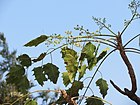Note: This is a project under development. The articles on this wiki are just being initiated and broadly incomplete. You can Help creating new pages.
Difference between revisions of "Ailanthus excelsa - Aralu, Indian tree of heaven"
(→Uses) |
(→Parts Used) |
||
| Line 7: | Line 7: | ||
==Parts Used== | ==Parts Used== | ||
| − | {{Parts Used|Leaves}}, {{Parts Used|Bark}}, {{Parts Used| | + | {{Parts Used|Leaves}}, {{Parts Used|Bark}}, {{Parts Used|Roots}} |
==Chemical Composition== | ==Chemical Composition== | ||
Revision as of 10:30, 14 March 2019
Ailanthus excelsa commonly known as tree of heaven, is a large deciduous tree found in India and Sri Lanka. In Tamil, it is also known as Pi-Nari Maram due to its disagreeable odour.There are many related species in Ailanthus.
Contents
- 1 Uses
- 2 Parts Used
- 3 Chemical Composition
- 4 Common names
- 5 Properties
- 6 Habit
- 7 Identification
- 8 List of Ayurvedic medicine in which the herb is used
- 9 Where to get the saplings
- 10 Mode of Propagation
- 11 How to plant/cultivate
- 12 Commonly seen growing in areas
- 13 Photo Gallery
- 14 References
- 15 External Links
Uses
Dropsy, Sore throat, Chronic dysentery, Worm infestation, Swellings, Haemorrhoid, Jaundice, Cold, Coughs, Catarrh, Anorexia, Flatulence, Abdominal discomfort, Eczema, Dental caries, Bleeding guns, Fever, Eye diseases, Piles, Migraines.
Parts Used
Chemical Composition
Malanthine, B-Sitosterol[1]
Common names
| Language | Common name |
|---|---|
| Kannada | Bende, Dodabevu, Dodda |
| Hindi | Mahanimb, Maharukh |
| Malayalam | Mattipongilyam, Peru, Perumaram |
| Tamil | Perumaram, Perumaruntu |
| Telugu | Pedda, Peddamandu, Peddamanu |
| Marathi | NA |
| Gujarathi | NA |
| Punjabi | NA |
| Kashmiri | NA |
| Sanskrit | Aralu, Araluka, Araluvrksa |
| English | Indian Tree of Heaven, Coramandel ailanto |
Properties
Reference: Dravya - Substance, Rasa - Taste, Guna - Qualities, Veerya - Potency, Vipaka - Post-digesion effect, Karma - Pharmacological activity, Prabhava - Therepeutics.
Dravya
Rasa
Tikta, Kashaya
Guna
Lagu, Ruksha
Veerya
Sheeta
Vipaka
Katu
Karma
Tridoshahaara
Prabhava
Habit
Identification
Leaf
| Kind | Shape | Feature |
|---|---|---|
| Hunse like | Oblong-lanceolate | Oblong-lanceolate is Subopposite, Leaf Apex is Acuminate, Leaf Base is Oblique and Leaf Margin is Irregularly toothed-sublobate |
.[2]
Flower
| Type | Size | Color and composition | Stamen | More information |
|---|---|---|---|---|
| Terminal panicles | 0.75 cm. long and 1 cm | Red or purple | 8-10 | Flowering from January-March |
Fruit
| Type | Size | Mass | Appearance | Seeds | More information |
|---|---|---|---|---|---|
| oblong samara | 7–10 mm (0.28–0.4 in.) long pome | prominently nerved, membranous | seed 1 | {{{6}}} |
Other features
List of Ayurvedic medicine in which the herb is used
- Vishatinduka Taila as root juice extract
Where to get the saplings
Mode of Propagation
How to plant/cultivate
A plant of the semi-arid to wet tropics, where it is found at elevations up to 900 metres. It grows best in areas where annual daytime temperatures are within the range 20 - 40°c, but can tolerate 4 - 47°c[3]
Commonly seen growing in areas
Photo Gallery
References
External Links
- Ayurvedic Herbs known to be helpful to treat Dropsy
- Ayurvedic Herbs known to be helpful to treat Sore throat
- Ayurvedic Herbs known to be helpful to treat Chronic dysentery
- Ayurvedic Herbs known to be helpful to treat Worm infestation
- Ayurvedic Herbs known to be helpful to treat Swellings
- Ayurvedic Herbs known to be helpful to treat Haemorrhoid
- Ayurvedic Herbs known to be helpful to treat Jaundice
- Ayurvedic Herbs known to be helpful to treat Cold
- Ayurvedic Herbs known to be helpful to treat Coughs
- Ayurvedic Herbs known to be helpful to treat Catarrh
- Ayurvedic Herbs known to be helpful to treat Anorexia
- Ayurvedic Herbs known to be helpful to treat Flatulence
- Ayurvedic Herbs known to be helpful to treat Abdominal discomfort
- Ayurvedic Herbs known to be helpful to treat Eczema
- Ayurvedic Herbs known to be helpful to treat Dental caries
- Ayurvedic Herbs known to be helpful to treat Bleeding guns
- Ayurvedic Herbs known to be helpful to treat Fever
- Ayurvedic Herbs known to be helpful to treat Eye diseases
- Ayurvedic Herbs known to be helpful to treat Piles
- Ayurvedic Herbs known to be helpful to treat Migraines
- Herbs with Leaves used in medicine
- Herbs with Bark used in medicine
- Herbs with Roots used in medicine
- Herbs with common name in Kannada
- Herbs with common name in Hindi
- Herbs with common name in Malayalam
- Herbs with common name in Tamil
- Herbs with common name in Telugu
- Herbs with common name in Sanskrit
- Herbs with common name in English
- Habit - Deciduous Tree
- Index of Plants which can be propagated by Seeds
- Herbs that are commonly seen in the region of Field border
- Herbs that are commonly seen in the region of Wet area
- Herbs




